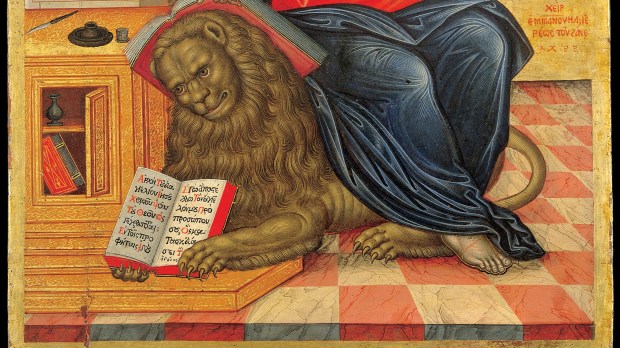The Church celebrates St. Mark the Evangelist April 25, and his Gospel is one of the most expressive, visual, and emotional Gospels, all while being the shortest.
In fact, the Gospel of Mark is like a movie in several ways, and I mean apart from the fact that the symbol of St. Mark is a lion, just like the MGM Studios logo.
First: Mark’s Gospel is much more visual than the other Gospels.
Mark has a way of helping us picture each scene.
- Jesus may put a child in the midst of his disciples in other Gospels, but Mark adds, “taking him into his arms, he said …”
- The other Gospels talk about feeding the 5,000, but only Mark tells us they sat in groups of “hundreds and fifties,” so we can see it.
- Mark even supplies a shocking image to show the full degradation of the disciples who fled in the Garden before the Resurrection: one fleeing disciple is caught by his clothes, and runs away without them.
Second: The Gospel of Mark is structured like a movie.
You have probably noticed the three-act structure in movies.
Act I is the inciting incident and rising action — the hero’s life is upset and they head toward a new goal. In the Gospel of Mark, this is the mysterious man Jesus appearing, predicted by John and surprising everybody with his strange teaching and unexpected powers.
Act II is the rising action, as complications come along, the stakes get raised and a twist at the midpoint of the movie changes everything. In the precise center of the Gospel of Mark, Jesus asks, “Who do you say that I am?” Peter answers “The Messiah” and Jesus tells them all he will suffer and die.
Act III is the climax where all seems lost — and Mark’s passion is the harshest — until the unexpected happy ending, the resurrection.
Third: Mark’s story builds mystery and suspense.
Jesus tells his disciples in Mark, “The mystery of the kingdom of God has been granted to you” but hidden from others.
The mystery is his identity. Mark emphasizes that Jesus wants to keep his identity secret. The demons know him, and he often quiets them. He tells lepers and others not to reveal him — sometimes unsuccessfully.
Fourth: Jesus in Mark is an “action hero.”
Jesus is always on the move in the Gospel of Mark, healing and exorcising demons. Mark says “immediately” 40 times in 16 chapters.
As Brant Pitre points out, Mark is as determined as John to show that Jesus is divine — only he reveals it through actions.
Fifth: Like in a movie, Mark gives us not just actions, but reactions.
Often in Mark, a side character draws our attention to the meaning of events dramatically.:
- Early on, onlookers ask, “What is this? A new teaching!”
- When Jesus forgives the paralytic, scribes ask “Why does this man speak thus?”
- When Jesus calms the storm, the apostles ask, “Who is this, that even the wind and sea obey him?”
Sixth: Mark always ratchets up the drama.
Examples of Mark’s dramatic touch abound:
- In other Gospels, Jesus “was led” into the desert by the Spirit. In Mark, the Spirit drove Jesus into the desert, where he was “among the wild beasts.”
- Other Gospels tell us about the Gerasene demoniacs. Mark paints a visceral picture: “Night and day among the tombs on the hillsides he was always crying out and bruising himself with stones.” Only Mark’s account ends with pigs drowning themselves.
- We hear about the woman with the hemorrhage elsewhere, but in Mark she had “suffered much under many physicians,” and had “spent all that she had,” and yet only “grew worse.”
Seventh: Mark shows the emotions of Jesus more than that the other Gospels.
He reacts to events with authentic human emotion: he gets angry and disappointed, he shows pity and surprise, he sighs deeply and is hungry, is admiring and at one point almost overwhelmed.
Mark also shares Jesus’ original words. Saying, “Talitha koum!” (little girl, rise!), and “Ephphatha” (be opened!) Jesus prays “Abba” (dad) and cries out from the cross “Eloi, Eloi, lema sabachthani?” (My God, my God, why have you forsaken me?)
Eighth: There is even a “trailer” for the Gospel of Mark “movie.”
Mark was a secretary to Peter, and many believe his Gospel to be Peter’s. In fact, when Peter tells the story of Christ in Acts, it reads like a summary of Mark — almost like a movie trailer.
Last: Mark’s Gospel even has a movie-poster tagline.
Mark begins his Gospel announcing that this is “the Good News about Jesus the Messiah, the son of God” and he uses the word “Gospel” more than any other evangelist. That’s a tagline for the ages.


